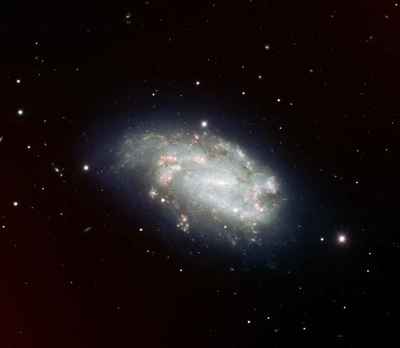Avi Blizovsky

Supernova 2005dh and the galaxy NGC 1559. European Southern Observatory photo ESO
Direct link to this page: https://www.hayadan.org.il/orvbitrinics.html
The southern network galaxy (Reticulum) is not an attractive site for amateur astronomers. It is tiny, cold and diamond shaped. Not far in the sky from the over-observed Large Magellanic Cloud. However, recently astronomers decided to look at the galaxy that is within this group. More specifically, they observed an exploding star located in the spiral galaxy NGC 1559.
On the night of August 4, 2005, the Australian amateur astronomer, a priest by profession, named Robert Evans discovered the supernova just slightly north of the galaxy using his 31 centimeter telescope which he photographed at a magnification of 13.8. The star is only 20 times fainter than the rest of the galaxy.
This is the 104th supernova discovered in 2005. It was named SN 2005df. Evans had already discovered two other supernovae in the same galaxy in 1984 (SN 1984J) and 1986 (SN 1986L).
The following night, astronomer Marilena Salvo and her Australian colleagues classified the supernova as an unusual type of supernova, occurring at least 10 days before reaching maximum brightness. Such a supernova is created as a result of the explosion of a small, compact star - a white dwarf in a binary star system. When the companion star poured material into the white dwarf, the white dwarf reached a critical mass and this led to fatal instability and a supernova.
This is exactly the type of supernova that Dietrich Baade, Ferdinando Part (Patat), both from Southern European Flood, the American from Japan, and Wang from Berkeley, and their colleagues are interested in.
In particular, they are studying the polarization characteristic of this type of supernova in order to learn more about their properties, important clues to the exact physics governing this final catastrophe of life near such stars.
They were given observation time on the FORS1 telescope, one of ESO's 8.2 meter diameter telescopes, and they photographed them at the same time as the astronomers on duty at the VLT. This observation was made on August 6.
From initial analyzes of the data, Wang and his colleagues said they found that SN 2005df closely resembled another supernova they had previously studied, SN 2001el, whose explosion they saw was particularly asymmetric.
NGC 1559 is a spiral galaxy located about 50 light years from us, and whose weight is similar to 10 billion suns, that is, 7 times smaller than the Milky Way.
This galaxy is moving away from us at a speed of 1,300 km/h, this galaxy is of the Zipart type. These galaxies are characterized by the brightness of their nucleus which radiates mainly in the blue and ultraviolet. Astronomers estimate that a gas mass of two suns per year turns into stars in this galaxy. Like most galaxies, NGC 1559 almost certainly has a black hole at its center, with a mass equivalent to 300 suns.
They knew the stars in their lives and in their deaths
For the press release of the European Southern Observatory (ESO)
https://www.hayadan.org.il/BuildaGate4/general2/data_card.php?Cat=~~~233590689~~~97&SiteName=hayadan
